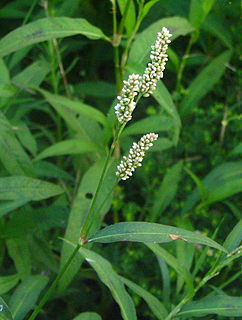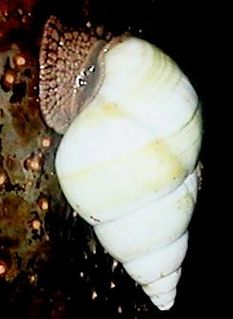
The Polygonaceae are a family of flowering plants known informally as the knotweed family or smartweed—buckwheat family in the United States. The name is based on the genus Polygonum, and was first used by Antoine Laurent de Jussieu in 1789 in his book, Genera Plantarum. The name may refer to the many swollen nodes the stems of some species have, being derived from Greek, poly meaning 'many' and gony meaning 'knee' or 'joint'. Alternatively, it may have a different derivation, meaning 'many seeds'.

Coccoloba is a genus of about 120–150 species of flowering plants in the family Polygonaceae, which is native to the Neotropics. There is no overall English name for the genus, although many of the individual species have widely used common names.

Coccoloba uvifera is a species of flowering plant in the buckwheat family, Polygonaceae, that is native to coastal beaches throughout tropical America and the Caribbean, including southern Florida, the Bahamas, the Greater and Lesser Antilles, and Bermuda. Common names include seagrape and baygrape.
Sea grape or seagrape may refer to:

Coccoloba pubescens, known as grandleaf seagrape, largeleaf, mountain-grape, and Eve's umbrella, is a species of Coccoloba native to coastal regions of the Caribbean: on Antigua, Barbados, Barbuda, Dominica, Hispaniola, Martinique, Montserrat, and Puerto Rico.

Muehlenbeckia or maidenhair is a genus of flowering plants in the family Polygonaceae. It is native to the borders of the Pacific, including South and North America, Papua New Guinea and Australasia. It has been introduced elsewhere, including Europe. Species vary in their growth habits, many being vines or shrubs. In some environments, rampant species can become weedy and difficult to eradicate.

Coccoloba diversifolia, known as pigeonplum or tietongue, is a species of the genus Coccoloba native to coastal areas of the Caribbean, Central America, southern Mexico, southern Florida and the Bahamas.

The Matlacha Pass National Wildlife Refuge is part of the United States National Wildlife Refuge System, located within the Matlacha Pass estuary, approximately 8 miles northwest of Cape Coral, Florida. The 538 acre (2.2 km2) refuge was established on September 26, 1908. It is administered as part of the J. N. "Ding" Darling National Wildlife Refuge Complex.

Liguus is a genus of large tropical air-breathing land snails, more specifically arboreal or tree snails, terrestrial pulmonate gastropod mollusks in the family Orthalicidae.

Coccoloba caracasana is a tree in the family Polygonaceae. It is known by the common name papaturro.

Daphnopsis hellerana is a rare species of flowering plant in the genus Daphnopsis of the family Thymelaeaceae. It is endemic to Puerto Rico, where there were only four populations remaining in 1992, with a total of 125 individuals. It was federally listed as an endangered species of the United States in 1988.

Muehlenbeckia australis, the large-leaved muehlenbeckia or pohuehue, is a prostrate or climbing plant native to New Zealand.
Halysidota cinctipes, the gartered halysidota or Florida tussock moth, is a species of moth in the family Erebidae. It was described by Augustus Radcliffe Grote in 1865. It is found on Cuba, Haiti, the Bahamas and in the US states of Florida, Texas, Arizona and California. The range possibly extends through Mexico, Guatemala, Costa Rica and Panama to Venezuela, Brazil and Peru.

Uvero, also known as El Uvero, is a Cuban village and consejo popular of the municipality of Guamá, in Santiago de Cuba Province. In 2011 it had a population of 2,581.
Rosalina Berazaín Iturralde is a Cuban botanist, plant collector, plant taxonomist, and professor at the University of Havana. She is one of the founders of the National Botanic Garden of Cuba, and a member of the Cuban Academy of Sciences. The standard author abbreviation Berazaín is used to indicate this person as the author when citing a botanical name. The species Coccoloba berazainae and Coccoloba berazainiae were named in her honor.
Coccoloba cereifera is a rare species in the genus Coccoloba. The species is restricted to a single mountain, the Serra do Cipó, in southern Brazil. The species is notable for its expression of a trioecious sexual system.

Coccoloba padiformis is a plant species in the genus Coccoloba. It is distributed in Mesoamerica and northern South America.
Coccoloba gigantifolia is a species of flowering plant in the knotweed family Polygonaceae. It is endemic to the Madeira River Basin in the states of Amazonas and Rondonia in the central and southwestern Brazilian Amazon. This species resembles that of Coccoloba mollis but differs in that it has much larger leaves in its fertile branches.
Trioecy is a extremely rare reproductive system characterized by the coexistence of males, females, and hermaphrodites. It has been found in both plants and animals.












